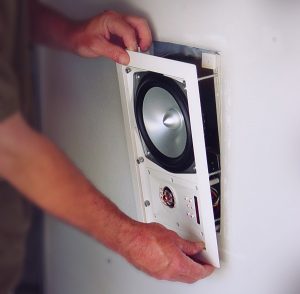The Myth of Wireless – Part 2
In part 1 of this series on the myths of wireless technology, we discussed the pros and cons of wireless devices and which is best for what application to provide homeowners the best combination of reliability, performance, and convenience. Click here to check out Part 1.
In this installment, we will discuss a specific category of devices: wireless speakers.
 When building or remodeling a home, it is common for an audio-video designer to ask homeowners about wiring speakers in various rooms throughout the house. These so-called distributed audio or whole-house speaker systems have been a staple of luxury homes since the 90s, providing background music for personal enjoyment and social occasions.
When building or remodeling a home, it is common for an audio-video designer to ask homeowners about wiring speakers in various rooms throughout the house. These so-called distributed audio or whole-house speaker systems have been a staple of luxury homes since the 90s, providing background music for personal enjoyment and social occasions.
These speaker systems often take the form of wiring through the walls to round or rectangle flush mount speakers, most often placed in ceilings. With controls ranging from wall keypads to smartphones, controlling audio in rooms across the home is easy and intuitive. The quality of such speakers range from basic to near audiophile. By far, such speaker systems are the most common audio-video sub-system installed in homes over the years.
In recent years manufacturers like Sonos, Bose, and many others have developed wireless speakers which shake up this traditional system plan, marketing their speakers as easy and wireless. Typically, these speakers are small shelf-top box speakers that sometimes are accompanied by a wireless subwoofer to improve the overall range of sound, and sometimes not. Most are not battery-powered and plug into a standard wall outlet; not so “wireless” as the product marketing department would lead us to believe.
So why do these products exist? For one thing, they have allowed companies to expand their product offerings in the search for more revenue, but also these products have an intended niche. In older homes where speaker wiring cannot be run through the walls, they are a great way to get audio in rooms where there was none. For people who move house often, a shelf top speaker is far easier to pack up and take along to the next home. Unfortunately, this is where the advantages end when compared to traditional distributed audio speaker systems.
“Wireless” Speakers vs. In-ceiling Speaker System.
Wireless Speaker
- Great for spaces where running speaker wire is not possible.
- Great for college kids moving from place to place.
- Usually accompanied by an easy-to-use smartphone app.
- While they are called “wireless”, most must be plugged into a wall outlet.
Traditional Speaker Systems
- Thousands more options in speaker choices allow the speaker selection to be optimized for the room, the budget, and the performance expectation.
- Not tethered to wall outlets, the speakers can be placed in positions for the best coverage and performance.
- In-ceiling speakers can be designed to match ceiling downlights, even the tiny LED ones.
- Ceiling speakers do not take up shelf space that could otherwise be used for books, art, or family photos.
While so-called wireless speakers do have some uses in certain situations, for most people building or remodeling a home the greater advantage lies in the traditional in-ceiling speaker system.
If you are considering a speaker system for your home, have a discussion with one of the system designers at Custom Audio Video about the best options for your home.











